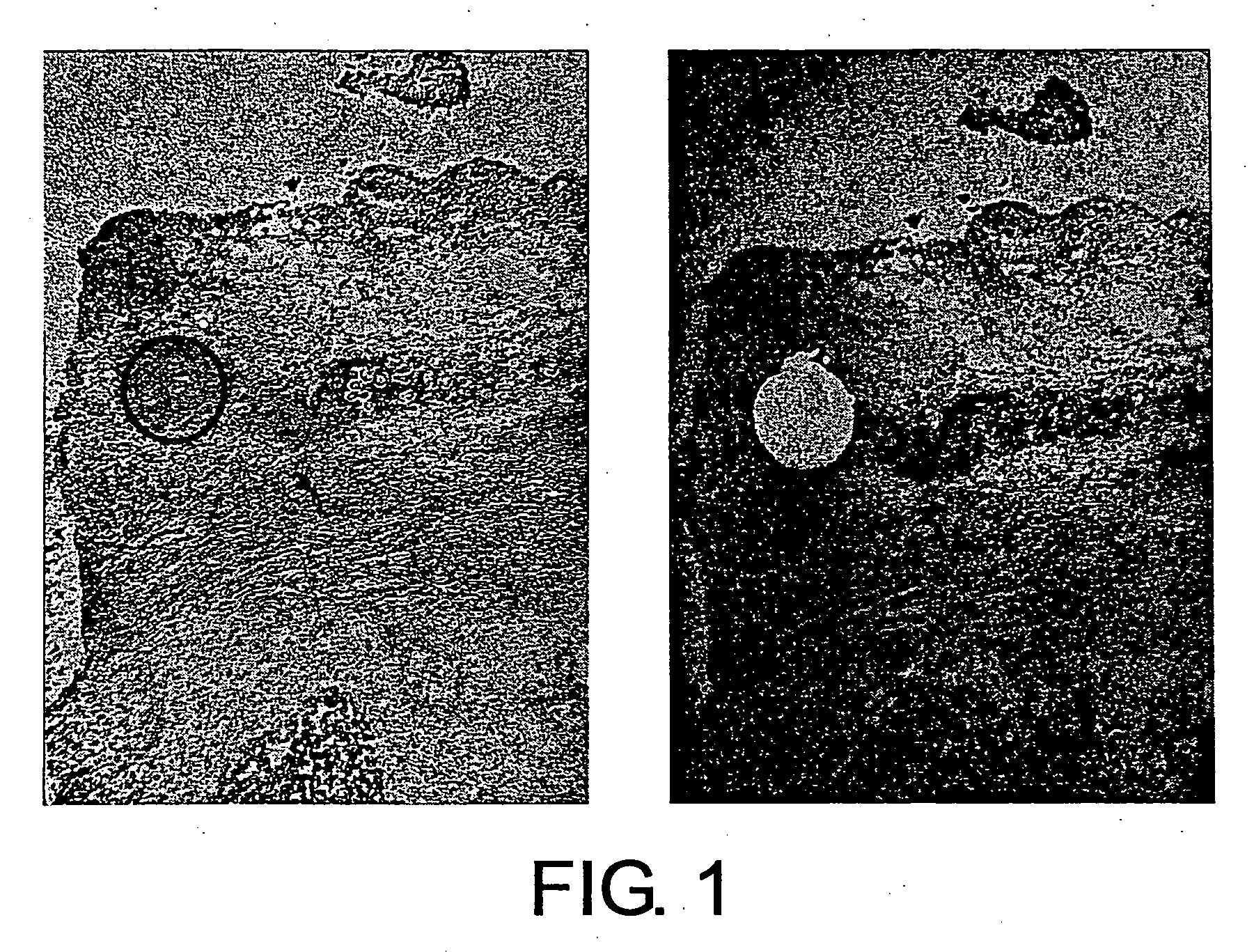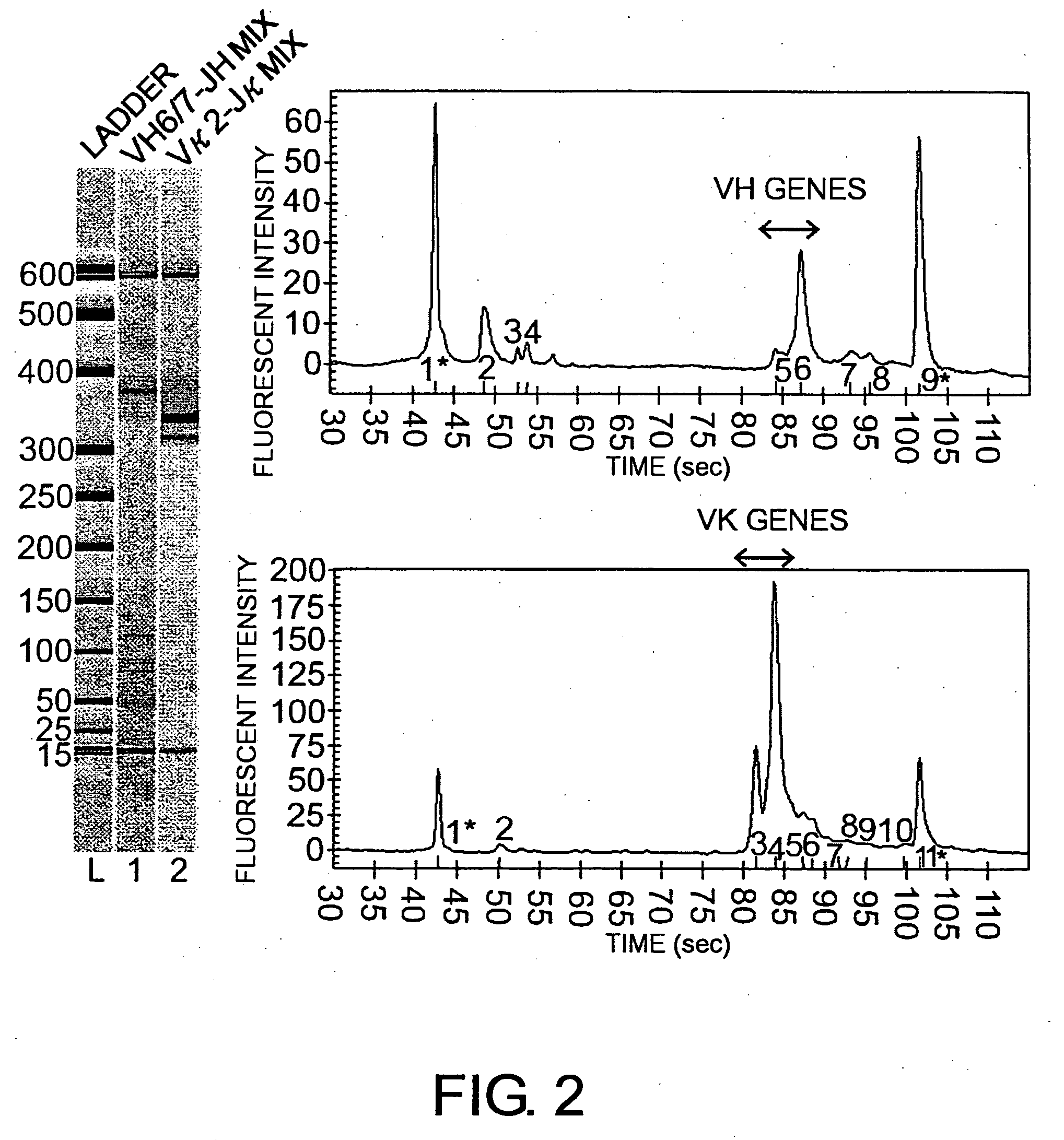Antibodies against lesion tissue
a technology of lesional tissue and antibodies, applied in the field of antibodies against lesional tissue, can solve problems such as difficulties in limitation, and achieve the effect of convenient use and higher probability
- Summary
- Abstract
- Description
- Claims
- Application Information
AI Technical Summary
Benefits of technology
Problems solved by technology
Method used
Image
Examples
example 1
LMD Isolation of a Single Cancer Tissue-Infiltrating B Cell
[0140] A fresh human tissue (breast cancer tissue) was sliced into a suitable size to prepare frozen blocks using an OCT compound (Tissue-tek), and fixed prior to freezing with fixatives such as paraformaldehyde-lysine-periodate, as necessary. Next, thin specimen sections were prepared from each frozen block and attached onto LMD slides (Matsunami Glass Co.). Resulting thin-section frozen specimens were dried in air, fixed with fixatives such as acetone, and stained with toluidine blue (Muto Pure Chemicals Co., Ltd) or such. After staining, plasma cells were excised with a laser microdissection system (Leica AS-LMD), and recovered using a recovery buffer (RLT solution attached to QIAGEN RNeasy Mini Kit). Plasma cells before and after the excision are shown in FIGS. 1, 5, 7, 9, 11, 13, and 15. In all figures, the left photograph shows the state of the cells before excision, and the right photograph shows the state of the cel...
example 2
RNA Preparation and cDNA Synthesis
[0141] A suspension of approximately one to five B cells excised from a thin-section LMD specimen was mixed with a suspension of about 300 carrier cells which do not express any antibody genes. Total RNAs were prepared from the resultant mixture, using the RNeasy Mini Kit (QIAGEN) according to the manufacturer's instructions. When 50 cells or more were excised from the thin-section specimen, total RNAs were prepared without the addition-of carrier cells. cDNA was synthesized using all 35 μl of the RNA eluate fraction as a template, and Sensiscript Reverse Transcriptase (QIAGEN) according to the manufacturer's instructions. cDNA synthesis reaction was performed on an 80-μl scale using 40 ng of Oligo dT primers (Promega) and 0.8 μg of random hexamers (Invitrogen) as the reverse transcription primers at 37° C. for 1 h. When cDNAs thus synthesized were not immediately subjected to PCR, they were stored at −80° C.
EXAMPLE 3
example 4
Preparation of Single-Stranded Antibody Molecules
[0145] The linker sequences to be used for preparing single-stranded antibody genes were produced according to the method of Marks et al. (J. Mol. Biol. (1991) 222, 581-597). The template DNA sequences and the nucleotide sequences of primers used in the preparation are shown below. Linker fragments synthesized using PCR amplification were confirmed by agarose gel electrophoresis, and bands containing the respective fragments were excised and purified.
Template DNA sequence (Template linker) / SEQ ID NO: 1515′-GGACAATGGTCACCGTCTCTTCAGGTGGTGGTGGTTCGGGTGGTGGTGGTTCGGGTGGTGGCGGATCGGACATCCAGATGACCCAGTCTCC-3′Nucleotide sequences of primers:Reverse JH for linker / SEQ ID NO: 152 to 155 1 LJH1_25′-GCACCCTGGTCACCGTCTCCTCAGGTGG-3′ 2 LJH35′-GGACAATGGTCACCGTCTCTTCAGGTGG-3′ 3 LJH4_55′-GAACCCTGGTCACCGTCTCCTCAGGTGG-3′ 4 LJH65′-GGACCACGGTCACCGTCTCCTCAGGTGG-3′Reverse VK for linker / SEQ ID NO: 156 to 161 5 LVK15′-GGAGACTGGGTCATCTGGATGTCCGATCCGCC-3′ 6 LVK25...
PUM
| Property | Measurement | Unit |
|---|---|---|
| Volume | aaaaa | aaaaa |
Abstract
Description
Claims
Application Information
 Login to View More
Login to View More - R&D
- Intellectual Property
- Life Sciences
- Materials
- Tech Scout
- Unparalleled Data Quality
- Higher Quality Content
- 60% Fewer Hallucinations
Browse by: Latest US Patents, China's latest patents, Technical Efficacy Thesaurus, Application Domain, Technology Topic, Popular Technical Reports.
© 2025 PatSnap. All rights reserved.Legal|Privacy policy|Modern Slavery Act Transparency Statement|Sitemap|About US| Contact US: help@patsnap.com



